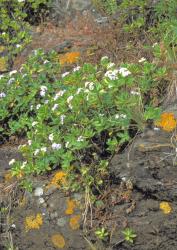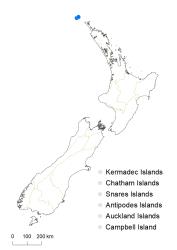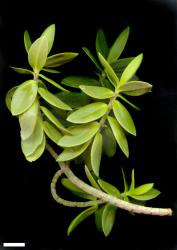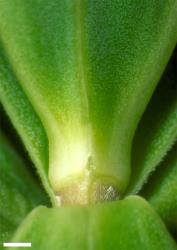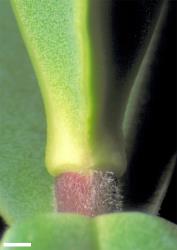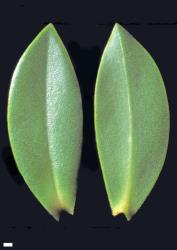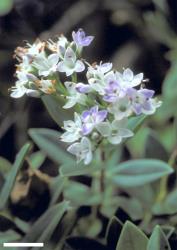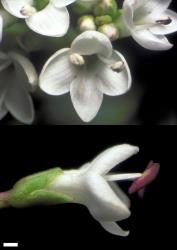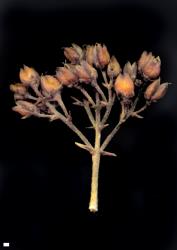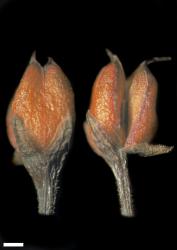- ≡ Hebe insularis (Cheeseman) Cockayne & Allan, Trans. New Zealand Inst. 57: 25 (1926)
Low shrub to 1 m tall. Stems decumbent to erect, sometimes pendent on cliffs, eglandular-pubescent; hairs usually uniform, sometimes bifarious. Leaf bud distinct, its leaves appressed at margins until fully grown; sinus absent or minute, oblong or acute. Leaves opposite-decussate, sometimes sub-distichous, erecto-patent to spreading or recurved; lamina fleshy to coriaceous, elliptic to slightly obovate, 7–33 mm long, 3–14 mm wide, dull, green to glaucous or glaucescent above, green beneath; midrib evident; surfaces usually glabrous or with scattered eglandular hairs along midrib beneath or on both sides, margin glabrous or sparsely eglandular-ciliolate to -ciliate, entire; apex acute to obtuse, weakly plicate-acuminate; base cuneate; petiole 1.0–1.5 mm long. Inflorescence a lateral ternate to compound raceme, 22–40 mm long, rarely to 90 mm; flowers crowded, 7–46, all bisexual; bracts opposite-decussate below, becoming alternate above, narrowly deltoid to ovate, usually <, sometimes ≥ pedicels; pedicels erecto-patent to spreading, 0.5–5.5 mm long, eglandular-hairy all around. Calyx lobes 4, free or anterior pair fused up to ⅔ way, usually acute, sometimes obtuse, 1.5–2.5 mm long, sub-equal, eglandular-ciliate, sometimes very sparsely, rarely with a few glandular cilia as well. Corolla 7–10 mm diameter; tube white, 3–4 mm long, > calyx, glabrous; lobes 4, white or pale purplish, erecto-patent to recurved, sub-equal, ovate to elliptic, 3.5–5.0 mm long, obtuse; nectar guides absent. Stamen filaments white, 4.8–6.5 mm long; anthers magenta. Style glabrous, 3.5–7.2 mm long. Capsules latiseptate, sub-acute or obtuse, glabrous, 2.5–4.5 mm long, 2.0–3.5 mm at widest point. Seeds ellipsoid, flattened, finely papillate, pale brown, 1.0–1.2 mm long.
Veronica insularis is a distinctive species, and it is the only Veronica indigenous to the Manawatāwhi / Three Kings Is. The very narrow or absent sinus is unique among species with branching inflorescences (Moore in Allan 1961), and other unusual characteristics include leathery, dull, elliptic, and often glaucous or glaucescent leaves; short, broad, ovate, acute, ciliate calyx lobes; branched inflorescences; slightly larger flowers than similar species; corolla lobes broad and rounded; and seeds finely papillate. Distinctive fine, tapering, stiff, eglandular hairs are dense on stems and inflorescences, but usually sparse on many leaves, especially on the margins and sometimes also the midribs, and on calyx lobe margins. The calyx lobes of V. insularis are almost entirely eglandular ciliate, sometimes sparsely so, but occasionally have a few glandular hairs mixed with the predominant eglandular ones, whereas in most hebes eglandular and glandular hairs are equally mixed.
Manawatāwhi / Three Kings Is. (Great, West, South West, and North East Is.).
Rock outcrops and cliffs, especially near the coast. Recorded elevations range from 5 to 207 m.
Flowers: November–February; fruits: December–March (persisting to August).
2n = 40 (see Bayly & Kellow 2006, as Hebe insularis).
Veronica insularis is classified in V. subg. Pseudoveronica sect. Hebe and the informal group “Apertae” (small-leaved) (Albach & Meudt 2010; Bayly & Kellow 2006). The pubescence and growth form are similar to some of the species on the Chatham Is., but ITS sequence data and inflorescence structure do not support a close relationship between them. Rather, V. insularis might belong to a grouping of species characterised by small, glaucous leaves, many of which also share leaf bud sinuses and compound racemes, such as V. scopulorum and V. colensoi.
Hairiness is variable. Stems usually have uniform dense hairs, but occasionally they are bifarious; leaves are sometimes glabrous, but often have scattered, fine, eglandular cilia along the margins, the midrib beneath, and occasionally above.



